The older you get, the more frequently your friends will show you pop culture works from decades past and ask you if you “feel old yet.” The world is showing those friends of yours grim little reminders that time is the villain who beats us all. Cast photos from cult classic TV shows populated by twenty-somethings, labeled side-by-side with the actors and actresses now in their late fifties. Best-selling rock albums featuring songs from the cringe fringes of our youth, with lyrics our adult selves cannot stand. Huge metal ball necklaces and glow-in-the-dark Tripp pants. None of it ever fazes me. Time, as best we can tell, is a linear thing. “Of course Nathan Fillion is old now,” I tell my friends to their astonishment. “But no, I don’t feel any differently.”
Balan Wonderworld fazed me. It wants to be a love letter to the gaming industry of two decades past, back when janky, early-3D platformers were a dime-a-dozen and your console’s success was defined in no small part by the popularity of the mascot characters therein. Crash Bandicoot, Banjo-Kazooie, Spyro the Dragon; kids banged on department store glass displays because they wanted to be those characters. That’s the nostalgia trip that Square Enix was likely banking on, but the titular Balan, for all his flashy attire, will be lucky if he’s remembered even half as fondly as lesser-known platforming peeps like Kya and Scaler.
I was fazed by the outdated nature of Balan Wonderworld‘s design philosophy. I was fazed by the fact that this is the brainchild of Yuji Naka, a delightfully creative fellow responsible in large part for the genesis of a platforming icon with even greater pedigree than your Bandicoots and your Banjos and your Spyros — Sonic the Hedgehog, Sega’s longest-lasting anthropomorphic icon. I was fazed by the reality that Square Enix not only approved this project but happily shipped it to stores. Balan Wonderworld is a trip down memory lane, specifically of the sort that reminds you the past isn’t all sunshine and rainbows. This is a video game marred by all the problems that 3D platformer designers faced in 2001, presented in 2021 as though no one ever solved a single one of them.
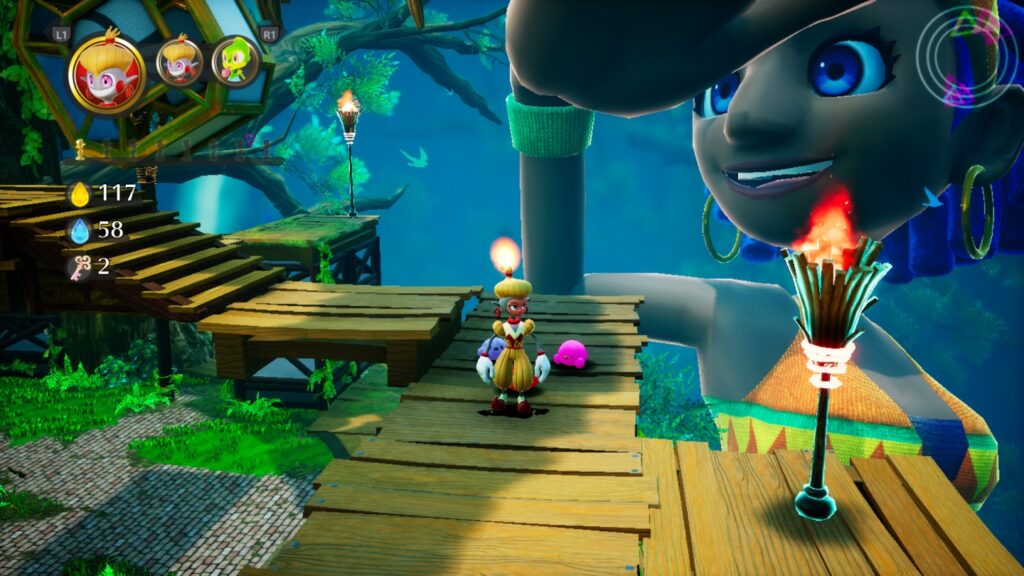
On its surface, Balan Wonderworld has a few things going for it. The game’s artists have employed a vibrant color palette, vivid and inviting, with a novel degree of visual diversity between stages. It is as if developer Arzest wants to arrest you with the sensation of experiencing one of your old favorites, now with the bells and whistles of an “HD remaster” treatment. Applied to another video game, a good video game, Wonderworld‘s flair might be celebrated for years to come.
What’s more, this is a game with sublime CG cutscene design. More than once, I’ve been asked if Arzest blew their whole budget on these cutscenes; they’re even more colorful than the in-game aesthetic and better-animated than plenty of recent forays into computer-generated films. Given that I am simply reviewing Balan Wonderworld and I do not, in fact, have any inside intel on the developmental balance sheet, I can’t say one way or another what happened here, but it wouldn’t surprise me to learn that stylishness was at the forefront of Yuji Naka’s mind, with little things like gameplay mechanics provided with far less time in the oven.
Yet for every word of praise above, there are asterisks attached that threaten to spoil the whole shebang. Balan Wonderworld is pretty when presented in the stillness of screenshots, but the splendor is soured by the game when it’s in motion. Lighting techniques fail to impress, texture pop-in can occur at the strangest times, and fleeting bits of beauty are universally marred by what is quite possibly the single worst camera system I’ve ever experienced in a video game. Wobbly, intrusive, flighty, disruptive, and at times downright destructive — I don’t know how they pulled it off, but Arzest has managed to make Super Mario 64 feel as polished in this regard as Super Mario Odyssey. Protip for Balan Wonderworld‘s photo mode: not even once. The thing is drunk.
Oh yeah, and everybody’s dancing, everywhere you go, for reasons unknown to your humble writer. Get too close to them and they disappear. Blink! They’re gone. The game gives up on them entirely, scolding the player for daring to walk up to these odd NPCs, for dreaming of asking them what in blazes they’re doing, and why.
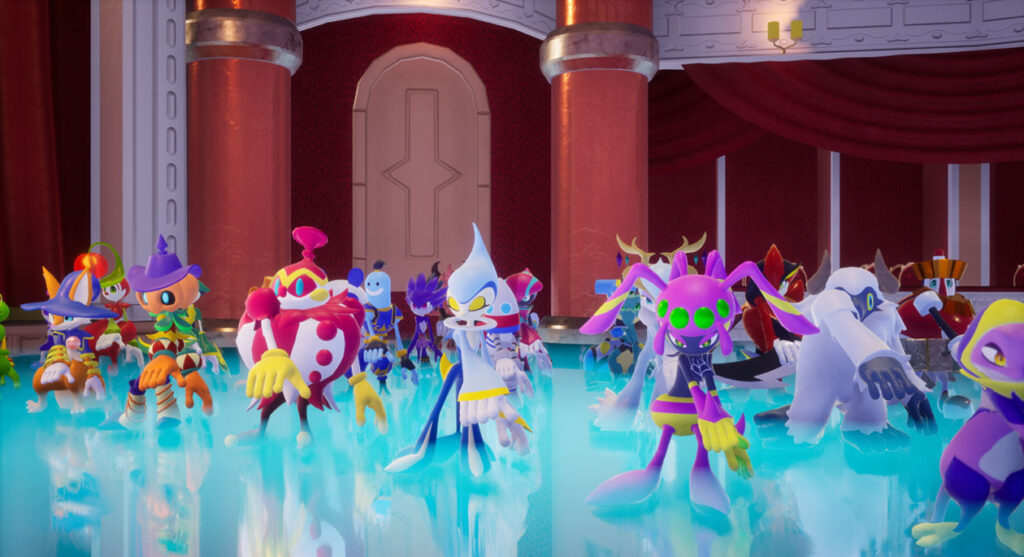
In fact, Balan Wonderworld actively scolds its players for daring to wonder anything at all. Its gorgeous cutscenes are mired in mystery, as vague as they are outlandish. They clearly attempt to tell you a story, but they lack the context necessary to do so. “Here’s what’s going down,” the game’s opening moments seem to say, introducing the audience to two sad kids who are sad because they’re sad, a jester-like man who isn’t sad because he isn’t sad, and a medley of bizarre secondary characters whose entire existence seems dominated by momentary dumbness. It’s the Rashomon effect if the Rashomon effect wasn’t about piecing together the truth from unreliable accounts, but rather, accepting that there is no truth, that the accounts themselves are nonexistent, and that friendly dolphins will venture into murderous rampages just because, happy-go-lucky again at the end just because.
That last bit isn’t me stretching a weird analogy to its brink. That really happens.
So the story’s a wash, but if you’re left confused about it, at least you can read a tie-in novel that will confuse you all over again because it provides much of the context that the game itself seems to have left blank. Well, that’s all right. Most of those old 3D platformers weren’t enormously interested in narrative, either, and some would argue that’s for the best. If Balan Wonderworld had thus succeeded at its genre’s core, delivering an exceptional platforming experience with shiny, vapid, plot tidbits, I’d be reasonably satisfied. Barring that, a passable joyride through a forgotten era roughly of the quality to be expected from the said era would have offered me an adequate if unimpressive stay-at-home weekend.
Amazingly, Balan Wonderworld delivers gameplay that seems substandard even for the bygone time it apes.
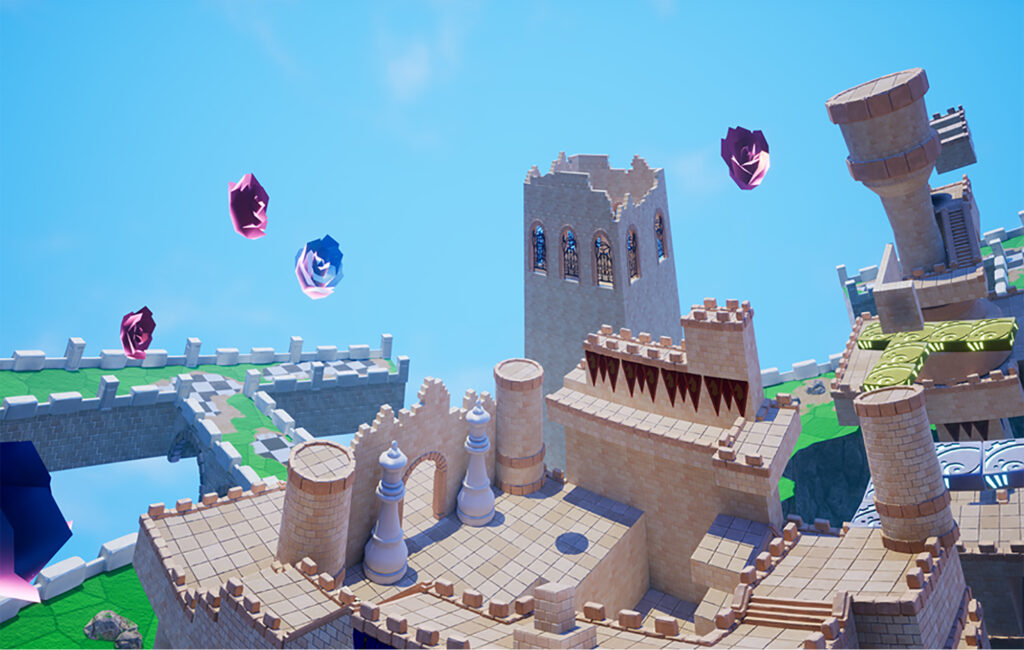
Level design is pedestrian at best. The challenge stems not from any concerted effort to make you think, but by the game’s insistence that you stay awake. Platformers live and die based on, well, platforming. The platforming in Balan Wonderworld is rote. It’s tired. It’s obvious to a fault. Environmental hazards are similarly safe, easily recognizable (and this in spite of the camera doing its damnedest to prevent you from recognizing anything) and hardly damaging in the first place. Encounters with antagonistic beasties are swift and decisive, not because they require any sense of strategy but because they seem to yearn for the sweet release of death, moving dimly in remarkably telegraphed motion and only occasionally remembering they’re supposed to fight you. I suppose, in a way, Balan‘s baddies are the most fleshed-out and sympathetic characters; who wouldn’t want off this rock?
“Thankfully,” you won’t have to stare at these brain-dead stages all the time, because you’ll periodically be pulled into what amounts to an unfinished background (cue jokes about Pokémon Sword & Shield‘s battle backdrops) where our buddy Balan abruptly tasks you with an inexplicable quick-time event and then throws you back from whence you came. It’s a little like an alien abduction, and — not unlike The X-Files — it never reaches a satisfactory conclusion. It never made sense to begin with.
The camera’s a wash, the level design is elementary except when it’s suddenly a hallucination, but what about the moment-to-moment button inputs? Great control schemes can help to right the most otherwise-sinking of video game ships. In Balan Wonderworld‘s case, every face button is jump. Jump, jump, jump… and jump. All right, so we’re springing for the most old-school of old-school approaches; I can almost respect the nerve. But even this most fundamental of features is poorly written-over by many of the game’s 80 collectible costumes, which constitute the closest thing to a beating heart the platformer manages to find.
Collecting costumes is more or less what you do in Balan Wonderworld, and you gather shrug-worthy MacGuffins along the way in order to unlock more stages so that you can continue collecting costumes. Problematically, many of these wardrobe suits are pure filler. The capabilities of one suit will be surpassed entirely by another, but the game’s structure seems to cry out in high hope that you’ll care about the mediocre suit nevertheless. It may be truer to say that every costume is mediocre; you can do exactly one thing with each of them, and that one thing outright replaces your ability to jump. That’s right, all of your face buttons have been overridden. You can now punch instead. Or kick a soccer ball. Or light up an area. Or launch a laser. Or become a dolphin, because surely we haven’t all been permanently scarred by the image of dolphins after that one scene.
Balan Wonderworld seeks to tap into that endorphin rush of chomping into a delicious candy bar that gacha mobile games achieve via rare pulls and the like, but Wonderworld’s candy bars are all the same flavor and there are only so many times I can savor a piece of Kinder Chocolate before I need a steak instead. It’s enough to make my head spin.
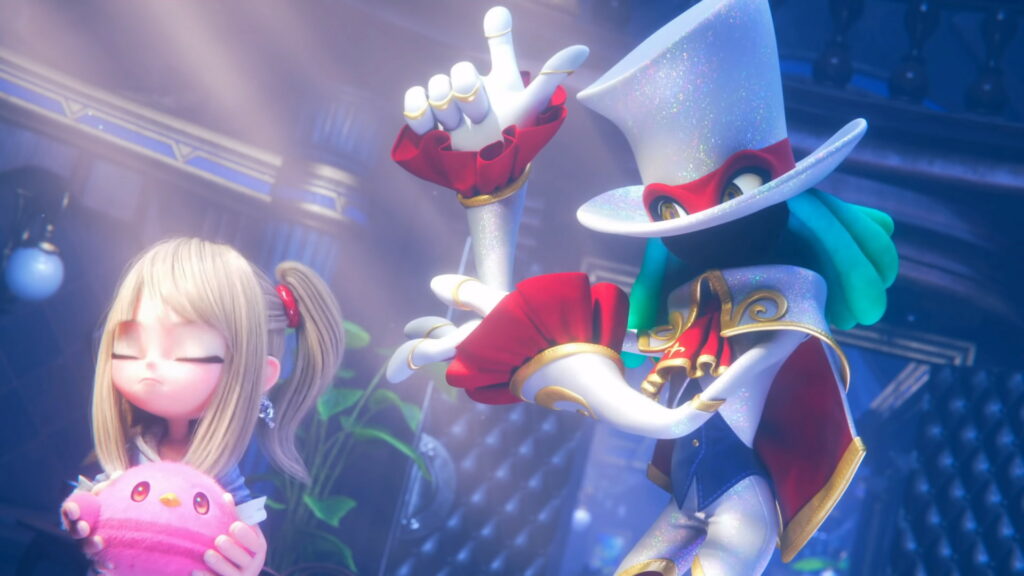
It’s all a bit much, but it never amounts to much at all. This is a video game that shares its premium price point with The Legend of Zelda: Breath of the Wild and Final Fantasy VII Remake. I’m astounded by the sheer scale of failure on display in this ostensibly AAA product. Even jumping feels wrong somehow in Balan Wonderworld; there’s a feeling that the game is tugging against you, only begrudgingly acknowledging that you’re attempting to play it.
At many points across my playthrough, I had to stop for a little while to catch some fresh air, or play with my pet, or water my plants, or talk to a roommate. Not because I needed the fresh air; I’d just returned from an outdoors excursion. Not because my pet needed attention; I’d cuddled with that cat all night. Not because my plants desperately needed watering; they’re cacti, they’ll be fine. And not because I had anything worthwhile to say to my roommates except exasperation. I needed to escape from the so-called wonderworld and take solace in the doldrums of reality. That’s not how video games are supposed to work.
The next time my friends ask me if I “feel old yet,” my answer will be yes. Not because I’ve been reminded that Farscape‘s teen heartthrob Ben Browder is 58 years old now. Not because I literally went to a Puddle of Mudd concert. Not because I used to trip on my own Tripp pants “and adults just didn’t understand me at all.”
Because I played Balan Wonderworld, and it sucked the life out of me.
Disclaimer: Review code provided by the publisher Square Enix.
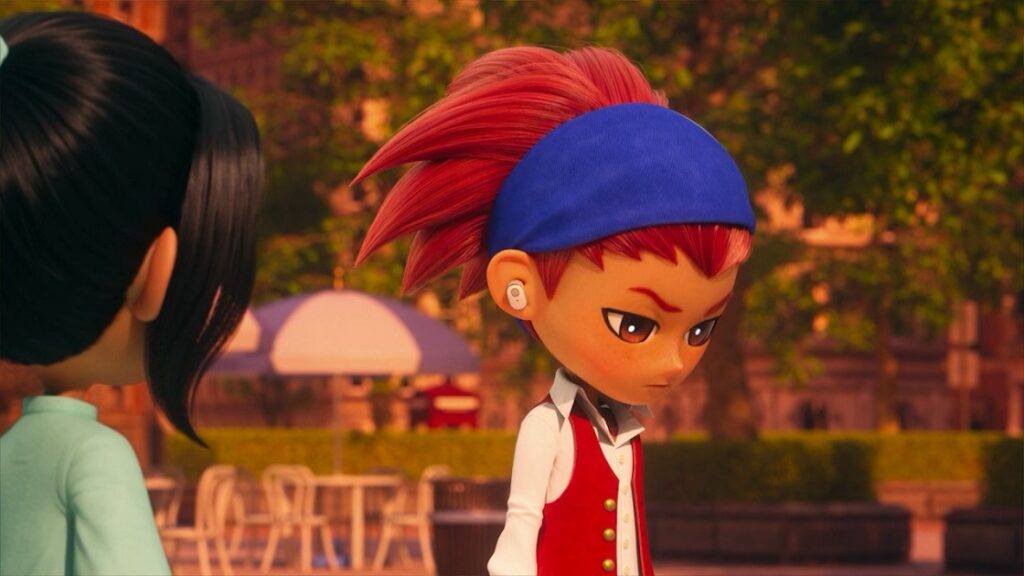
Recent Comments